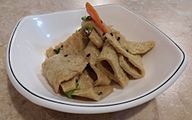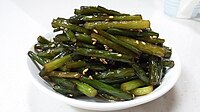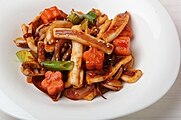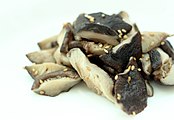Bokkeum
Stir-fry | |
| Place of origin | Korea |
|---|---|
| Associated cuisine | Korean cuisine |
| Korean name | |
| Hangul | 볶음 |
|---|---|
| Revised Romanization | bokkeum |
| McCune–Reischauer | pokkŭm |
| IPA | [po.k͈ɯm] |
 |
| This article is part of a series on |
| Korean cuisine 한국 요리 조선 료리 |
|---|
Bokkeum (Korean: 볶음) is a category of stir-fried dishes in Korean cuisine.[1]
Etymology
Bokkeum (볶음) is a verbal noun derived from the Korean verb bokkda (볶다), meaning "to cook food or food ingredients with little or a small amount of liquid by stir-frying over heat".[2]
Varieties
There are dry bokkeum varieties and wet (or moist) bokkeum varieties.[3]
Dry
- bokkeum-bap (볶음밥) – fried rice
- dak-ttongjip (닭똥집) – stir-fried chicken gizzards
- gamja-chae-bokkeum (감자채볶음) – stir-fried julienned potatoes
- glass noodles
- myeolchi-bokkeum (멸치볶음) – stir-fried anchovies
- ojingeo-chae-bokkeum (오징어채볶음) – stir-fried dried shredded squid
Wet
- dak-galbi (닭갈비) – stir-fried chicken
- jeyuk-bokkeum (제육볶음) – stir-fried pork
- nakji-bokkeum (낙지볶음) – stir-fried long arm octopus
- songi-bokkeum (송이볶음) – stir-fried matsutake
- tteok-bokki (떡볶이) – stir-fried rice cakes
- kimchi-bokkeum (김치볶음) – stir-fried Kimchi
- soseji yachae bokk-eum(소세지야채볶음) - stir fried sausage vegetable
Gallery
-
Aehobak-bokkeum (stir-friedKorean zucchini)
-
Eomuk-bokkeum (stir-friedfishcakes)
-
Goguma-julgi-bokkeum (stir-fried sweet potato stems)
-
Gomjangeo-bokkeum (stir-fried hagfish)
-
Jeyuk-bokkeum (stir-fried pork)
-
Jukkumi-bokkeum (stir-fried webfoot octopus)
-
Maneul-jong-bokkeum (stir-friedgarlic scapes)
-
Myeolchi-bokkeum (stir-friedanchovies)
-
Nakji-bokkeum (stir-fried long arm octopus)
-
Ojingeo-bokkeum (stir-fried squid)
-
Pyogo-bokkeum (stir-fried shiitake)
See also
Wikimedia Commons has media related to Bokkeum.
References
- ^ "The general kinds of Korean Food". Korea Tourism Organization. Retrieved 4 April 2013.
- ^ "bokkda" 볶다. Standard Korean Language Dictionary (in Korean). National Institute of Korean Language. Retrieved 27 May 2017.
- ^ 이, 효지. "bokkeum" 볶음. Encyclopedia of Korean Culture (in Korean). Academy of Korean Studies. Retrieved 27 May 2017.











